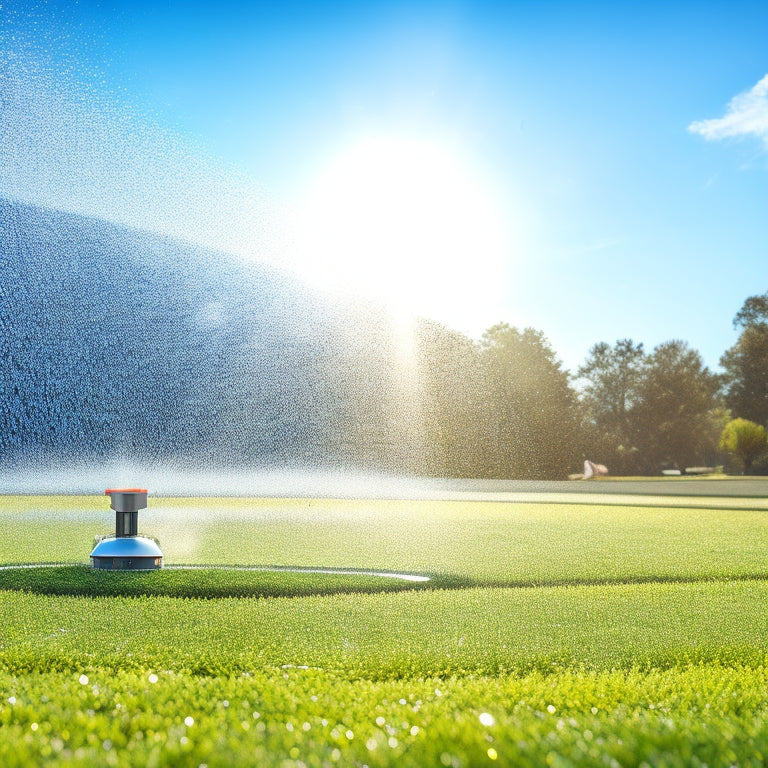
What Lawn Irrigation Methods Save Water and Energy?
Share
By incorporating smart irrigation controllers, rain sensor technology, and drip irrigation systems into your lawn care routine, you can markedly reduce water waste and energy consumption. These advanced technologies enable real-time monitoring and automated adjustments based on current weather conditions, optimizing water distribution and minimizing overwatering. Additionally, low-flow sprinkler heads and grey water reuse systems can further conserve resources. By adopting these eco-friendly methods, you can maintain a healthy, thriving lawn while saving water and energy - and exploring these innovative solutions in more detail can reveal even greater benefits for your lawn and the environment.
Key Takeaways
- Smart irrigation controllers with real-time weather monitoring and automated adjustments optimize water distribution and reduce waste.
- Rain sensor technology and automated watering pause features conserve water by skipping irrigation sessions during rainfall.
- Drip irrigation systems and low-flow sprinkler heads deliver water directly to plant roots, minimizing evaporation and reducing water consumption.
- Weather-based irrigation management and soil moisture sensor integration tailor watering schedules to current weather conditions, reducing water waste by up to 20%.
- Implementing water conservation strategies like rainwater harvesting, xeriscaping, and grey water reuse systems can significantly reduce potable water reliance and energy consumption.
Smart Irrigation Controllers
As you step into the world of efficient lawn irrigation, a sleek, modern timer mounted on your garage wall catches your eye - a smart irrigation controller. This device is the brain of your irrigation system, optimizing water distribution with precision.
You'll appreciate the smart controller features, such as real-time weather monitoring and automated adjustments. With irrigation app integration, you can control your system remotely, receiving notifications and updates on your smartphone.
By leveraging fast charging infrastructure, smart irrigation controllers can also optimize energy efficiency, reducing waste and promoting eco-friendly practices. The controller's advanced capabilities also enable it to adapt to changing weather conditions, much like energy storage systems that optimize solar charging.
The controller's intuitive interface allows you to customize schedules, monitor water usage, and make adjustments on the fly. Enjoy the freedom to manage your lawn's hydration from anywhere, at any time, and rest assured your lawn will thrive while conserving precious resources.
Rain Sensor Technology Benefits
When you integrate rain sensor technology into your lawn irrigation system, you'll experience the benefits of automated watering pause, which saves you water and reduces waste.
Similarly, solar-powered EV charging stations can attract eco-conscious consumers, increasing foot traffic and business opportunities commercial EV charging stations.
With real-time moisture monitoring, you'll have a clear visual of your lawn's moisture levels, allowing you to make informed decisions about when to irrigate.
This technology enables smart irrigation decisions, as your system can adjust its schedule based on actual weather conditions, ensuring your lawn receives the right amount of water at the right time.
Automated Watering Pause
By integrating rain sensor technology into your lawn irrigation system, you can automatically pause watering during rainfall, reducing unnecessary water waste and preventing overwatering.
This automated pause feature guarantees that your lawn only receives the right amount of water, allowing you to optimize water management and irrigation scheduling.
With real-time weather data, the system adjusts its watering schedule accordingly, giving you peace of mind and freedom from worrying about water waste.
Additionally, incorporating eco-friendly practices, such as renewable energy sources, can further minimize your environmental footprint.
This technology is particularly useful in areas with unpredictable weather patterns, where sudden rainfall can occur without notice.
Real-Time Moisture Monitoring
Your lawn irrigation system's rain sensor technology takes water management to the next level with real-time moisture monitoring. This advanced feature enables you to optimize water distribution, ensuring your lawn receives the perfect amount of hydration.
By calibrating the sensor to your specific soil type and moisture thresholds, you can trust that your system will automatically adjust to changing weather conditions. Additionally, adopting renewable energy sources, such as solar power, can greatly reduce the carbon footprint of your irrigation system, contributing to a more sustainable future renewable energy solutions.
Visualize the sensor continuously monitoring soil moisture levels, providing instant data to fine-tune your irrigation schedule. This precise control allows you to make informed decisions, reducing water waste and conserving this precious resource.
With real-time moisture monitoring, you're free to enjoy a lush, lively lawn while minimizing your environmental footprint.
Smart Irrigation Decisions
Rain sensor technology enables you to make smart irrigation decisions, leveraging real-time data to optimize water distribution and minimize waste.
With this technology, you can automatically adjust irrigation schedules based on weather conditions, ensuring your lawn receives the right amount of water.
By integrating rain sensors into your irrigation system, you'll reduce water consumption and lower your energy bills.
As seen in commercial EV charging stations, solar-powered systems can markedly reduce energy costs and carbon emissions.
This approach supports sustainable landscaping practices, allowing you to create a thriving environment for native plants.
Drip Irrigation Systems Advantages
You'll find that drip irrigation systems offer a highly effective way to conserve water, as they deliver it directly to the roots of plants, reducing evaporation and runoff.
This targeted approach enables you to optimize water distribution, ensuring that your lawn receives the right amount of moisture exactly where it's needed.
Water Conservation Methods
A well-designed lawn irrigation system can be a significant water guzzler, but incorporating water conservation methods can drastically reduce its thirst.
By adopting these strategies, you'll not only save water but also enjoy a lush, healthy lawn while reducing your environmental footprint.
-
Implement rainwater harvesting systems to collect and store rainwater for irrigation, reducing your reliance on potable water.
-
Use xeriscaping techniques to create a low-water environment that requires minimal irrigation.
-
Install moisture sensors to detect soil moisture levels and adjust irrigation schedules accordingly, eliminating unnecessary watering.
- Incorporate drought-tolerant plants into your environment design, reducing the need for frequent watering.
Efficient Water Distribution
With efficient water distribution, every drop counts. You can achieve this by implementing water distribution techniques that guarantee each plant receives the right amount of water at the right time.
Drip irrigation systems, for instance, deliver water directly to the roots, reducing evaporation and runoff. This efficient irrigation strategy allows you to control water flow, adjusting it according to soil type, plant species, and weather conditions.
Weather-Based Watering Schedules
Across various regions, lawn irrigation systems are increasingly adopting weather-based watering schedules to optimize water usage and minimize waste. By tailoring your watering schedule to current weather conditions, you can guarantee your lawn receives the right amount of water at the right time. This approach takes into account factors like evapotranspiration rates, which vary depending on temperature, humidity, and wind speed.
-
You can make seasonal adjustments to your watering schedule to accommodate changes in weather patterns and plant growth.
-
Weather-based watering schedules can be integrated with smart irrigation controllers, allowing for real-time adjustments based on weather forecasts and soil moisture levels.
-
This approach can help reduce water waste by up to 20% and lower your energy bills.
- By optimizing water usage, you'll also reduce the risk of overwatering, which can lead to shallow root growth and increased susceptibility to disease.
Soil Moisture Sensor Integration
Your lawn's soil moisture levels play an important role in determining the ideal watering schedule. To guarantee optimal irrigation, consider integrating soil moisture sensors into your system.
Proper sensor placement is essential, typically 2-4 inches below the soil surface. Calibration techniques involve setting moisture thresholds to trigger watering events. Data analysis allows you to refine these thresholds based on environmental factors like temperature and precipitation.
Integration challenges arise when combining sensors with existing irrigation systems, so confirm system compatibility. Choose from sensor types like tensiometers or time-domain reflectometry sensors.
Regular maintenance protocols, such as cleaning and replacing sensors, are critical. User-friendly interfaces enable easy monitoring and adjustment of your soil moisture sensor integration, giving you the freedom to enhance your lawn's watering schedule.
Low-Flow Sprinkler Heads Options
Low-flow sprinkler heads are a revolutionary development in lawn irrigation, offering a water-efficient solution for homeowners and garden designers alike. By installing these innovative sprinkler heads, you'll greatly reduce water consumption while maintaining a lush, colorful lawn.
-
Take advantage of micro spray technology, which delivers water directly to the roots of plants, minimizing evaporation and runoff.
-
Adjustable nozzles allow you to customize water distribution patterns, ensuring precise coverage and eliminating waste.
-
Low-flow sprinkler heads feature precision-engineered orifices that optimize water flow, resulting in uniform water distribution and reduced consumption.
- Many low-flow sprinkler heads are designed with built-in filters, protecting your system from debris and clogs, and reducing maintenance requirements.
Grey Water Reuse Systems
The grey water reuse system you're considering for your lawn irrigation method is a forward-thinking approach that can greatly reduce your potable water usage.
By collecting and treating grey water from sinks, showers, and washing machines, you can create a sustainable source for garden irrigation. A grey water filtration system will remove contaminants and sediment, ensuring the water is safe for your lawn.
This approach not only conserves water but also reduces your energy consumption and reliance on municipal supplies.
With a well-designed grey water reuse system, you can enjoy a lush, healthy lawn while doing your part for the environment.
Frequently Asked Questions
Can I Use Rainwater Collection Systems With My Existing Irrigation Setup?
You can definitely integrate rainwater collection systems with your existing irrigation setup, utilizing rainwater benefits while ensuring irrigation compatibility; just connect the collection tank to your current system, and enjoy the freedom of reduced water bills and environmental guilt!
How Often Should I Inspect and Clean My Irrigation System?
You should inspect your irrigation system monthly, checking for clogs, leaks, and worn parts, and perform a deep clean quarterly, to guarantee ideal system maintenance and prevent water waste, giving you the freedom to enjoy a lush lawn.
Are There Any Lawn Irrigation Methods Suitable for Small Lawns?
You'll find that drip irrigation and soaker hoses are perfect for small lawns, supplying water directly to roots, reducing evaporation, and minimizing waste, giving you a lush, lively lawn while embracing freedom from water and energy worries.
Can I Install a Lawn Irrigation System Myself or Do I Need a Pro?
You can attempt a DIY installation, but complex systems or large lawns may require professional assistance; consider your technical skills, time, and lawn size before deciding, and weigh the benefits of each approach carefully.
Are There Any Government Incentives for Water-Efficient Irrigation Systems?
When you're digging deep for savings, strike gold with government rebates for water-efficient irrigation systems, which can offset installation costs and support your water conservation efforts, giving you the freedom to irrigate responsibly.
Related Posts
-

3 Ways Wind Power Boosts Home Value
Living near a wind farm can enhance your property's value in three significant ways. To begin with, proximity to wind...
-

3 Earth-Loving Furniture Tips for Energy-Smart Homes
When furnishing your energy-smart home, you have the power to reduce your carbon footprint greatly by making consciou...
-

Why Grow Up? Vertical Gardens Transform Urban Living
As you change your urban living space, you're not just growing up - you're bringing nature back into the heart of the...


